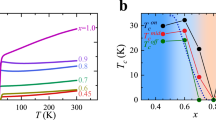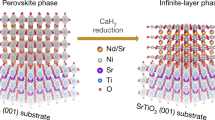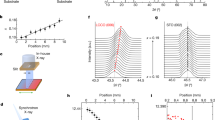Abstract
High-temperature superconductivity in copper oxides arises when a parent insulator compound is doped beyond some critical concentration; what exactly happens at this superconductor–insulator transition is a key open question1. The cleanest approach is to tune the carrier density using the electric field effect2,3,4,5,6,7; for example, it was learned in this way5 that weak electron localization transforms superconducting SrTiO3 into a Fermi-glass insulator. But in the copper oxides this has been a long-standing technical challenge3, because perfect ultrathin films and huge local fields (>109 V m−1) are needed. Recently, such fields have been obtained using electrolytes or ionic liquids in the electric double-layer transistor configuration8,9,10. Here we report synthesis of epitaxial films of La2− xSr x CuO4 that are one unit cell thick, and fabrication of double-layer transistors. Very large fields and induced changes in surface carrier density enable shifts in the critical temperature by up to 30 K. Hundreds of resistance versus temperature and carrier density curves were recorded and shown to collapse onto a single function, as predicted for a two-dimensional superconductor–insulator transition11,12,13,14. The observed critical resistance is precisely the quantum resistance for pairs, RQ = h/(2e)2 = 6.45 kΩ, suggestive of a phase transition driven by quantum phase fluctuations, and Cooper pair (de)localization.
This is a preview of subscription content, access via your institution
Access options
Subscribe to this journal
Receive 51 print issues and online access
$199.00 per year
only $3.90 per issue
Buy this article
- Purchase on Springer Link
- Instant access to full article PDF
Prices may be subject to local taxes which are calculated during checkout


Similar content being viewed by others
References
Lee, P. A., Nagaosa, N. & Wen, X. G. Doping a Mott insulator: physics of high-temperature superconductivity. Rev. Mod. Phys. 78, 17–85 (2006)
Parendo, K. A. et al. Electrostatic tuning of the superconductor-insulator transition in two dimensions. Phys. Rev. Lett. 94, 197004 (2005)
Ahn, C. H. et al. Electrostatic modification of novel materials. Rev. Mod. Phys. 78, 1185–1212 (2006)
Matthey, D., Reyren, N., Triscone, J.-M. & Schneider, T. Electric-field-effect modulation of the transition temperature, mobile carrier density, and in-plane penetration depth of NdBa2Cu3O7-δ thin films. Phys. Rev. Lett. 98, 057002 (2007)
Caviglia, A. D. et al. Electric field control of the LaAlO3/SrTiO3 interface ground state. Nature 456, 624–627 (2008)
Bell, C. et al. Dominant mobility modulation by the electric field effect at the LaAlO3/SrTiO3 Interface. Phys. Rev. Lett. 103, 226802 (2009)
Biscaras, J. et al. Two-dimensional superconductivity at a Mott insulator/band insulator interface LaTiO3/SrTiO3 . Nature Commun. 1, 1–5 (2010)
Ueno, K. et al. Electric-field-induced superconductivity in an insulator. Nature Mater. 7, 855–858 (2008)
Ye, J. T. et al. Liquid-gated interface superconductivity on an atomically flat film. Nature Mater. 9, 125–128 (2010)
Dhoot, A. S. et al. Increased T c in electrolyte-gated cuprates. Adv. Mater. 22, 2529–2533 (2010)
Sondhi, S. L., Grivin, S. M., Carini, J. P. & Shahar, D. Continuous quantum phase transitions. Rev. Mod. Phys. 69, 315–333 (1997)
Fisher, M. P. A., Grinstein, G. & Girvin, S. M. Presence of quantum diffusion in two dimensions: universal resistance at the superconductor-insulator transition. Phys. Rev. Lett. 64, 587–590 (1990)
Goldman, A. M. & Markovic´, N. Superconductor-insulator transitions in the two-dimensional limit. Phys. Today 51, 39–44 (1998)
Gantmakher, V. F. & Dolgopolov, V. T. Superconductor-insulator quantum phase transition. Phys. Usp. 53, 1–49 (2010)
Gozar, A. et al. High-temperature interface superconductivity between metallic and insulating copper oxides. Nature 455, 782–785 (2008)
Logvenov, G., Gozar, A. & Bozovic, I. High-temperature superconductivity in a single copper-oxygen plane. Science 326, 699–702 (2009)
Smadici, S. et al. Superconducting transition at 38 K in insulating-overdoped La2CuO4-La1. 64Sr0. 36CuO4 superlattices: evidence for interface electronic redistribution from resonant soft X-ray scattering. Phys. Rev. Lett. 102, 107004 (2009)
Wang, T. et al. Onset of high-temperature superconductivity in the two-dimensional limit. Phys. Rev. B 43, 8623–8626 (1991)
Yazdani, A. & Kapitulnik, A. Superconducting-insulating transition in two-dimensional α-MoGe thin films. Phys. Rev. Lett. 74, 3037–3040 (1995)
Mason, N. & Kapitulnik, A. Dissipation effects on the superconductor-insulator transition in 2D superconductors. Phys. Rev. Lett. 82, 5341–5344 (1999)
Herbut, I. F. Critical exponents at the superconductor-insulator transition in dirty-boson systems. Phys. Rev. B 61, 14723–14726 (2000)
Phillips, P. & Dalidovich, D. The elusive Bose metal. Science 302, 243–247 (2003)
Steiner, M. A., Breznay, N. P. & Kapitulnik, A. Approach to a superconductor-to-Bose-insulator transition in disordered films. Phys. Rev. B 77, 212501 (2008)
Tesˇanovic´, Z. d-wave duality and its reflections in high-temperature superconductors. Nature Phys. 4, 408–414 (2008)
Li, L., Checkelsky, J. G., Komiya, S., Ando, Y. & Ong, N. P. Low-temperature vortex liquid in La2-x Sr x CuO4 . Nature Phys. 3, 311–314 (2007)
Valla, T., Fedorov, A. V., Lee, J., Davis, J. C. & Gu, G. D. The ground state of the pseudogap in cuprate superconductors. Science 314, 1914–1916 (2006)
Bilbro, L. S. et al. Temporal correlations of superconductivity above the transition temperature in La2-x Sr x CuO4 probed by terahertz spectroscopy. Nature Phys. 7, 298–302 (2011)
Emery, V. J. & Kivelson, S. A. Importance of phase fluctuations in superconductors with small superfluid density. Nature 374, 434–437 (1995)
Broun, D. M. et al. Superfluid density in a highly underdoped YBa2Cu3O6+y superconductor. Phys. Rev. Lett. 99, 237003 (2007)
Hetel, I., Lemberger, T. R. & Randeria, M. Quantum critical behaviour in the superfluid density of strongly underdoped ultrathin copper oxide films. Nature Phys. 3, 700–702 (2007)
Acknowledgements
The work at BNL was supported by the US Department of Energy, Basic Energy Sciences, Materials Sciences and Engineering Division. A.T.B. was supported by the US DOE, Energy Frontier Research Center. D.P. and G.D. were supported by the Laboratory for Physics of Complex Matter (EPFL) and the Swiss National Science Foundation. We are grateful to A. Tsvelik, J. C. Davis, A. Balatsky, P. N. Armitage, A. Goldman, V. Gantmakher, I. Herbut, Z. Tes̆anović, A. Chubukov, J. Mannhart, J.-M. Triscone, N. Marković, N. Mason and M. Norman for comments and suggestions and to R. Adzić, G. Logvenov, J. Pereiro, J. Sadovsky and R. Sundling for technical help.
Author information
Authors and Affiliations
Contributions
I.B. and A.T.B. conceived and designed the experiments. I.B. synthesized the films. A.T.B. fabricated the devices. A.T.B., G.D. and J.Y. carried out the transport measurements. All authors analysed the results and contributed to writing the manuscript.
Corresponding author
Ethics declarations
Competing interests
The authors declare no competing financial interests.
Supplementary information
Supplementary Information
This file contains Supplementary Text, Supplementary Figures 1-16 with legends and additional references. (PDF 2694 kb)
PowerPoint slides
Rights and permissions
About this article
Cite this article
Bollinger, A., Dubuis, G., Yoon, J. et al. Superconductor–insulator transition in La2 − xSr x CuO4 at the pair quantum resistance. Nature 472, 458–460 (2011). https://doi.org/10.1038/nature09998
Received:
Accepted:
Published:
Issue Date:
DOI: https://doi.org/10.1038/nature09998
This article is cited by
-
Reversible metal-insulator transition in SrIrO3 ultrathin layers by field effect control of inversion symmetry breaking
Communications Materials (2023)
-
Zero-dimensionality of a scaled-down VO2 metal-insulator transition via high-resolution electrostatic gating
NPG Asia Materials (2023)
-
Review of the role of ionic liquids in two-dimensional materials
Frontiers of Physics (2023)
-
Electrical mapping of thermoelectric power factor in WO3 thin film
Scientific Reports (2022)
-
Signatures of a strange metal in a bosonic system
Nature (2022)
Comments
By submitting a comment you agree to abide by our Terms and Community Guidelines. If you find something abusive or that does not comply with our terms or guidelines please flag it as inappropriate.



